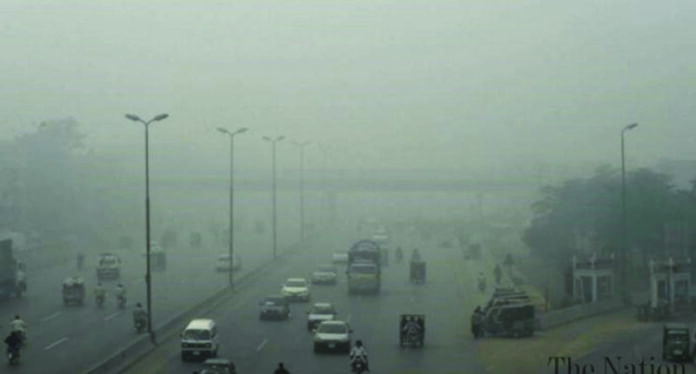The skies over Lahore and much of Punjab have become a toxic haze, a stark reminder of Pakistan’s growing environmental crisis. Smog, once a seasonal nuisance, has escalated into a full-blown health emergency, choking millions of residents with each passing year. What was once an occasional occurrence is now a regular, debilitating feature of life in the region. As smog episodes intensify and spread, the air quality deteriorates, and the impact on public health and the environment grows more severe. To truly grasp the depth of this crisis, we must look beyond the visible smoke and fog and explore the root causes, the history of this growing menace, and the urgent solutions needed to clear the air and protect Pakistan’s future.
Smog in Pakistan, especially in Punjab, has worsened in recent decades due to human activities, environmental mismanagement, and inadequate policies. Lahore, with its growing population, industrial expansion, and traffic congestion, is at the epicentre of this crisis. Smog forms when pollutants from vehicles, industries, and agriculture mix with atmospheric moisture, creating a toxic fog, particularly in winter when cool temperatures trap pollutants. The rapid increase in vehicles, coupled with poor maintenance and lack of strict emission controls, significantly contributes to this pollution. With over 6.2 million vehicles and 4.2 million motorbikes in Lahore and 19.6 million in Punjab, the lack of effective regulations has helped make Lahore the second most polluted city in the world, following Delhi.
Industrial emissions are another major contributor to smog in Punjab, which has experienced rapid industrial growth in recent years. Factories, brick kilns, and power plants, many of which burn fossil fuels like coal and oil, release large quantities of particulate matter, sulphur dioxide, and carbon monoxide into the air. These emissions are often poorly regulated, and the lack of effective environmental monitoring and enforcement has allowed industries to pollute the atmosphere with little accountability. Agricultural practices, particularly the burning of crop residue after the rice harvest in October and November, add to the smog. Farmers burn leftover stalks and straw to clear fields for the next planting season, releasing large amounts of smoke, particulate matter, and carbon dioxide. This practice, driven by a lack of alternatives, not only affects rural areas but also contributes to urban smog, as the smoke often drifts into cities, worsening air quality.
The seasonal weather patterns also play a role in the formation and persistence of smog. During the winter months, Lahore and other cities in Punjab experience a temperature inversion, a meteorological phenomenon in which a layer of warm air traps the cooler air near the ground. This phenomenon creates a situation where pollutants are trapped in the lower atmosphere, leading to smog formation. Smog is made up of fine particulate matter (PM2.5) and other toxic gases, which are harmful to human health when inhaled. Prolonged exposure to smog can lead to respiratory problems such as asthma, bronchitis, and even lung cancer. It also increases cardiovascular diseases, particularly among vulnerable populations such as children, the elderly, and those with pre-existing health conditions. The toxic air can irritate the eyes, throat, and skin, leading to widespread complaints of discomfort and illness. According to a report by the WHO, air pollution in Pakistan, particularly in urban centres like Lahore, is one of the leading causes of premature death, with thousands of people dying each year due to respiratory diseases linked to poor air quality.
Coupled to health issues, smog has significant economic consequences. The poor air quality often results in reduced visibility, which disrupts transportation, delays flights at airports, and increases the number of road accidents. In Lahore, schools and businesses sometimes close when air quality deteriorates, leading to loss of productivity. The increased number of health-related issues places a burden on the healthcare system, further straining the country’s already limited resources. The smog crisis not only affects the environment and public health but also has a detrimental impact on the economy.
Given the complex and multifactorial nature of the smog problem, addressing it requires a comprehensive and multi-pronged approach. One of the most urgent steps is to implement stricter vehicular emission standards and improve public transportation. The government must enforce stricter regulations on vehicle emissions, ensuring that only those vehicles meeting modern emission standards are allowed to operate. Regular vehicle inspections, fines for non-compliance, and incentives for upgrading to more environmentally friendly vehicles are key steps in reducing vehicular pollution. Investing in public transportation infrastructure, such as replacing motorbikes with e-bikes/scooters, and promoting the use of eco-friendly transport options like electric buses and trains, could significantly reduce the number of private vehicles on the road.
In the industrial sector, the government needs to tighten regulations and improve enforcement of environmental standards. Factories, brick kilns, and power plants should be required to install emission control technologies, such as scrubbers and filters, to reduce the release of harmful pollutants. Industries that rely on coal or other high-emission fuels should be incentivized to switch to cleaner alternatives, such as natural gas or renewable energy sources. The government can also encourage the adoption of green technologies and practices through subsidies and tax breaks for environmentally friendly industries. The government should work closely with farmers to promote sustainable farming practices and provide incentives for alternatives to burning crop residue. One potential solution is to encourage the use of crop residue for bioenergy production or composting, which would not only reduce pollution but also provide an economic benefit to farmers. The government could also promote the use of machines like happy seeders, which allow for the direct sowing of seeds without the need for burning the stubble. Public awareness campaigns that educate farmers about the environmental and health impacts of crop burning are also essential to changing behaviour in rural areas.
Looking to global examples of success, cities like Copenhagen, Zurich, and Vancouver, which consistently rank among the best in air quality, offer valuable lessons. By coordinating with these cities and adopting their best practices, Pakistan can accelerate its efforts toward cleaner air. Only through collaborative action and a collective commitment to environmental sustainability can Pakistan hope to restore its skies, protect the well-being of its citizens, and build a healthier, more prosperous future for generations to come.
Urban areas like Lahore need to adopt sustainable urban planning practices that prioritize green spaces and reduce congestion. Trees and vegetation play a vital role in absorbing pollutants and improving air quality, so increasing the city’s green cover through afforestation programmes can significantly help in reducing smog. Rather than focusing on non-native tree species like palms, eucalyptus, and other foreign varieties, the Punjab Horticulture Authority should prioritize planting indigenous trees suited to local soils and climates. Native trees such as peepal (Ficus religiosa), bargad (Ficus benghalensis), neem (Azadirachta indica), sukhchain (Melia azedarach), and kikar (Acacia arabica) are better equipped to thrive in Punjab’s environment. These trees not only produce more oxygen and absorb greater amounts of carbon dioxide, but their deep-root systems also help prevent soil erosion and reduce dust, making them highly effective in mitigating smog.
The government must also forge strategic partnerships with international organizations, research institutions, and civil society groups to create a comprehensive, transparent air quality monitoring and enforcement system. Continuous monitoring, combined with the rigorous implementation of environmental regulations, will be essential to track progress, ensure accountability, and drive meaningful change.
Looking to global examples of success, cities like Copenhagen, Zurich, and Vancouver, which consistently rank among the best in air quality, offer valuable lessons. By coordinating with these cities and adopting their best practices, Pakistan can accelerate its efforts toward cleaner air. Only through collaborative action and a collective commitment to environmental sustainability can Pakistan hope to restore its skies, protect the well-being of its citizens, and build a healthier, more prosperous future for generations to come.






















